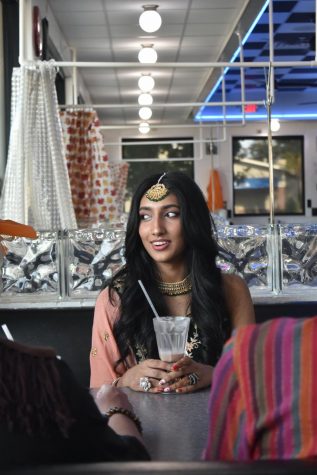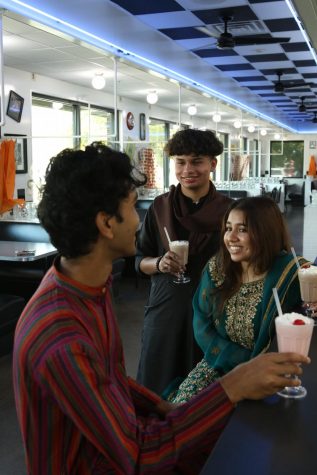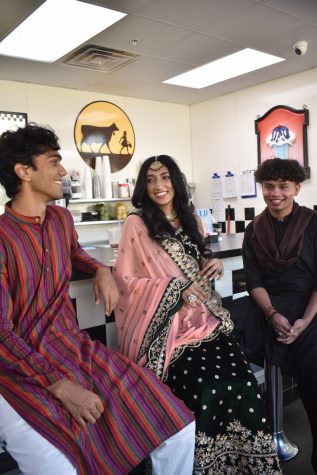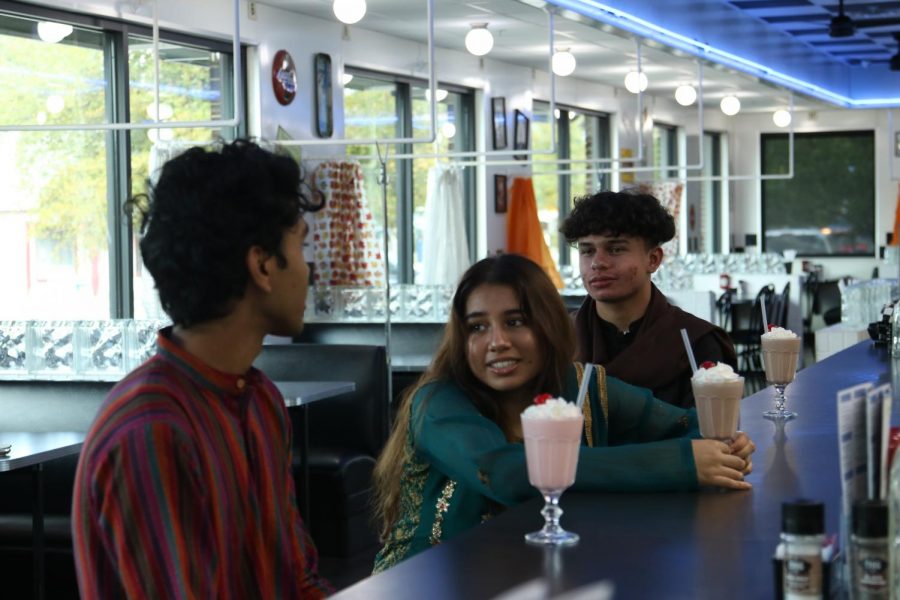Making a new home
Detailing the flux of South Asians immigrants
November 5, 2021
Coppell South Asian seniors Rudra Raval, Jaserah Chowdary and Arsalan Rivsi wear culturally significant clothing while juxtaposing the classic American diner. In recent years, South Asian immigration has risen significantly within Coppell, and Coppell ISD continues to develop and diversify to accommodate new incoming students.
“Oh, you live in brown town, bro.”
“That place is peak brown town.”
If someone lives in brown town, they are referring to a space that has been inhabited by a flux of South Asian immigrants in the United States. This term can be applicable to most communities in Coppell, also referred to as Desi communities.
The term “South Asian” refers to a total of six countries: India, Sri Lanka, Bangladesh, Bhutan, Nepal and Pakistan. When the Immigration and Nationality Act of 1965, also known as the Hart-Celler Act, was established in the United States, a flux of South Asians immigrated to Coppell primarily for better opportunities in education and the workforce. As of 2021, Asians are the second largest race in Coppell, making up 26.5 percent of the population.
Coppell High School senior Anoushka Kishore emigrated from India in 2012 for her dad’s employment opportunities. Kishore has lived in four states ever since (North Carolina, Iowa, Nevada and Texas), but thinks Coppell feels closest to home.
“Not only are we surrounded by a higher population of ethnic people, it was easy to just become part of the family at CHS,” Kishore said. “They are very welcoming and I have experienced very little racism as a whole compared to North Carolina or Iowa.”

Though Kishore hasn’t experienced any form of racism, prejudice against South Asians is still prevalent in Texas through the form of public hate speech, social media and word of mouth. CHS junior Sowbarnika Morsa has experienced first hand racism from both other races and her own.
“I definitely think there is a problem,” Morsa said. “When it comes to racism, it’s more like people not accepting the fact that I am Indian. I’ve heard many times in my life where people will be like ‘you’re not [Indian], you’re lying about it, when I try and consistently follow the journey that is the type of racist. Not only are people of different ethnicities racist to each other, but people of their own kind too, so it’s pretty ironic how a person of the same [race] as you is racist towards you.”
CHS Principal Laura Springer also acknowledges these issues and hopes to make CHS an inclusive and kind community.
“The problem is not being willing to change your viewpoints on things,” Springer said. “Our goal is to try to find everybody and meet them in the middle. I’m not trying to change anybody’s culture. I want you to be happy about your culture. I want you to be proud of your culture. I want to be proud of your heritage. I don’t want to change anybody’s heritage. What I want is to bring a group of people together from all parts of our world and make sure they realize when you come here, it’s our differences that make us better. It’s what makes us stronger. And to make sure that we don’t have to like everyone, but we have to respect each other and we have to get along. That’s what we have the FISH Philosophy for. That’s what we have GRIT for.”
Both Springer and Morsa think informing the community about these issues in order to fix them.
“Especially in classrooms where we could do choice readings to give different choices so we open up kids’ minds with the opportunity to see the fact that when we come in this building, we have always taught one way,” Springer said. “And we don’t always have to teach one way. It makes others feel welcome in this building, too. And make everybody feel like they have a place and a home within our school. It doesn’t mean we have to change our life to be like that, but it means it helps us to understand each other better to understand the things that we’ve each been through. We need to realize how lucky we have it and how wonderful our community and our school system is, but also to be very cognizant of what others have gone through before they’ve come to us. And let’s hear about that experience. Let’s learn from that experience. Because we know that’s not something that we would ever want to have to live through ourselves.”
Implementing diverse curriculum into classrooms is one way the school is seeking to increase inclusivity. Coppell High School IB English teacher Richard Orlopp has chosen Gold Diggers by Sanjena Sathian, a South Asian focused novel, for the summer reading book for his students.
“I thought the issues would resonate with many of the students I teach,” Orlopp said. “I think it’s important to teach [inclusivity] because it helps us have a window into other cultures. The greatest thing about reading fiction is that it creates that sense of empathy in people, and I just get really interested to see other places, other ways of life.”
With the rise of South Asian immigrants also comes a need to recognize cultural holidays and celebrations. Festivals such as Navaratri and Diwali are prominent and widely celebrated in the South Asian community. Officially recognizing these South Asian celebrations have become a civil rights debate for many years, questioning the value of diversity that has been placed in the Coppell community.
Governor Greg Abbott declared October as Hindu Heritage month for the state of Texas, proclaiming, “Communities of faith have long served as beacons of hope, sharing their beliefs and bettering their communities through service. Improving and inspiring the lives of thousands of followers around the world, Hinduism has contributed greatly to our state and nation through its unique history and heritage.”

Asians are the largest racial group in Coppell ISD, making up 51.6 percent of the population. With the flux of immigration also comes the double standard of being South Asian-American, battling issues such as racism and fighting for civil rights.
Language demographics are also changing as CISD becomes more South Asian heavy. In 2015, Spanish speakers were the largest non-English speakers of the community with 28.2 percent of CISD students and Telugu 16 percent. In 2019, Spanish speakers dropped to 21.7 percent and Telugu rose up to 20.8, making it almost the same.
“Since we kind of have a lot of the same languages growing up and the same experiences and culture, we expect to see each other at festivals or outside of school,” Kishore said. “That brings us closer together because it’s a tighter connection between all of us, and we can depend on each other whenever we need to.”
There are many South Asians representing CISD in different ways. Though CISD Place 2 trustee Manish Sethi is one of two South Asians in the CISD board of trustees, he still maintains a holistic view when making policies in the school board. Making sure he takes all students into account, Sethi and the board don’t make any rules or regulations based on racial biases.
“It is true that I tend to represent the community, but that’s not the goal when you work at the school board,” Sethi said. “Our responsibility is to serve every kid. The thought is always about representing everybody. But it definitely is a privilege and honor to be an Indian and pledge representative, offering interconnectedness in the school board.”
Being the dominant population in CISD, the pressure for academic achievement increased among students. Phrases such as “The Asian A” trigger these expectations that trail into a heavy portion of the student population. These increased academic standards are displayed in past and recent years’ STAAR scores, with Asians being one of the highest-scoring groups in CHS.
“I definitely think there is a higher level of competition, and that’s just because of the expectations and standards we have within our culture,” Kishore said. “But I think that we all understand that these are the expectations we have. It is kind of like a race to the top but at the end of the day, we all know what we’re going through, we all know what’s going on at home so it’s nice to know that you’re not feeling alone.”
While CISD offers many types of co-curricular and extracurricular activities, Sethi thinks South Asians tend to gravitate towards and away from the same types of ventures in school.
“Every culture has a way of upbringing their child and their priorities may differ,” Sethi said. “Asian families have a higher priority towards academics compared to non-Asian communities, where there is importance to sports and extracurriculars. But that doesn’t stop us. There are students like [CHS senior and Stanford commit Ryan Agarwal] who was the second Indian to receive a basketball scholarship to a [Division I] school.”
Accommodating to everyone in Coppell is one of the most important factors for Manish to consider when making decisions in the school board.
“When it comes to focusing on different communities we need to make sure we are making policies for everybody,” Sethi said. “When given so many choices, it does come with a share of challenges as finances become an issue, but these are good challenges. It forces us to give so many choices to our entire CISD community.”

Coppell South Asian seniors Rudra Raval, Trisha Vegad and Arsalan Rivsi wear culturally significant clothing while juxtaposing the classic American diner. In recent years, South Asian immigration has risen significantly within Coppell, and Coppell ISD continues to develop and diversify to accommodate new incoming students. (Angelina Liu)
With a school that provides so many options for every student, it can be tough to decipher which path is right for each individual. Immigrating from South Asia, located halfway across the world and adjusting to a new environment can be daunting. CHS special education teacher Hemalatha Bhatt thinks a large school such as CHS needs to make new students aware of everything it has to offer in order for the students to optimize their time in high school.
“Many parents come and they have students that are not born here,” Bhatt said. “[Students] come at the age of 11 or 12, and [parents] don’t know what kind of opportunities they have for their students, [especially] those who are special ed. So I think they need to learn more. All the information [can be] overwhelming. The teachers and staff can contribute when people come to CISD and we can give more information.”
Bhatt, Kishore and Sethi have immigrated from India to Coppell for better job opportunities for them or their families and have settled into the Coppell community with people of similar ethnicities surrounding them. Every community has challenges, but overall, CISD continues to develop a more diverse and inclusive culture to accommodate incoming citizens. With more and more immigrants, South Asians in Coppell have started to form tighter bonds and embrace their culture freely.
“Represent your culture, promote and come forward,” Bhatt said. “Some of our community are hesitant to come forward and show what our heritage is. Whenever we have a culture night, all of [the students] should participate. Whatever specialty they have in their own culture, they should [share], so other people can understand what we have in our roots and what we inherit.”
As South Asian immigrants continue to rise, Coppell recognizes that it is also important for cultural education to rise parallelly.
“The thing about living in a Metroplex that we live in is we’ve always been a migrant community almost, where we have people and different cultures coming in,” Springer said. “For me, it’s been fantastic because I think South Asian culture is all about education. It’s also a new culture that I’m learning so much about. You’re a person I want to learn from and I hope you learn from me and we become fast friends and we understand each other. It’s been really good and not just academically but socially and emotionally and I’m thrilled that we have the rise of our South Asian immigrants.”
Follow Sreeja (@sreejamudumby) and @CHSCampusNews on Twitter.

